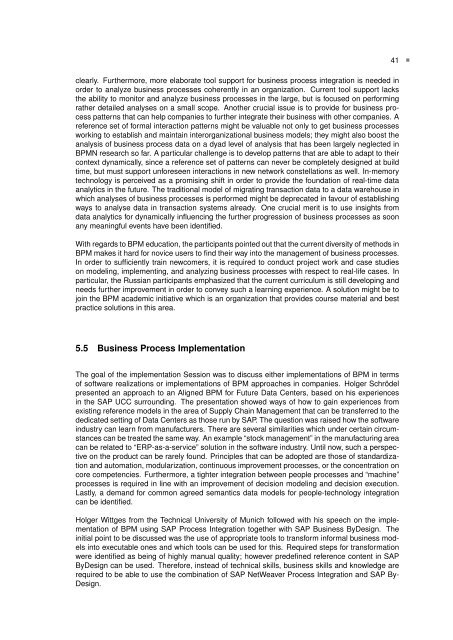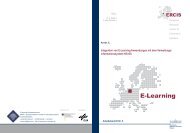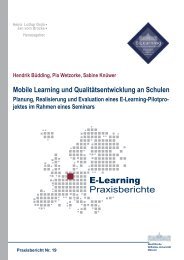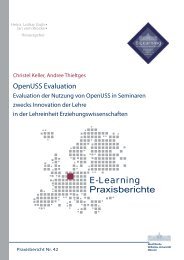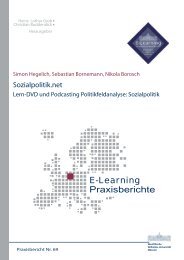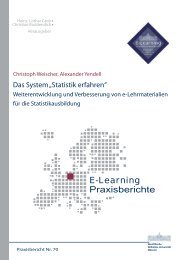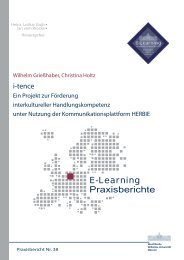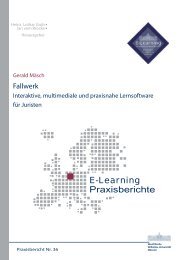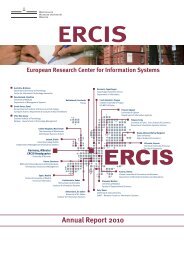Promoting Business Process Management Excellence in Russia
Promoting Business Process Management Excellence in Russia
Promoting Business Process Management Excellence in Russia
You also want an ePaper? Increase the reach of your titles
YUMPU automatically turns print PDFs into web optimized ePapers that Google loves.
41<br />
<br />
clearly. Furthermore, more elaborate tool support for bus<strong>in</strong>ess process <strong>in</strong>tegration is needed <strong>in</strong><br />
order to analyze bus<strong>in</strong>ess processes coherently <strong>in</strong> an organization. Current tool support lacks<br />
the ability to monitor and analyze bus<strong>in</strong>ess processes <strong>in</strong> the large, but is focused on perform<strong>in</strong>g<br />
rather detailed analyses on a small scope. Another crucial issue is to provide for bus<strong>in</strong>ess process<br />
patterns that can help companies to further <strong>in</strong>tegrate their bus<strong>in</strong>ess with other companies. A<br />
reference set of formal <strong>in</strong>teraction patterns might be valuable not only to get bus<strong>in</strong>ess processes<br />
work<strong>in</strong>g to establish and ma<strong>in</strong>ta<strong>in</strong> <strong>in</strong>terorganizational bus<strong>in</strong>ess models; they might also boost the<br />
analysis of bus<strong>in</strong>ess process data on a dyad level of analysis that has been largely neglected <strong>in</strong><br />
BPMN research so far. A particular challenge is to develop patterns that are able to adapt to their<br />
context dynamically, s<strong>in</strong>ce a reference set of patterns can never be completely designed at build<br />
time, but must support unforeseen <strong>in</strong>teractions <strong>in</strong> new network constellations as well. In-memory<br />
technology is perceived as a promis<strong>in</strong>g shift <strong>in</strong> order to provide the foundation of real-time data<br />
analytics <strong>in</strong> the future. The traditional model of migrat<strong>in</strong>g transaction data to a data warehouse <strong>in</strong><br />
which analyses of bus<strong>in</strong>ess processes is performed might be deprecated <strong>in</strong> favour of establish<strong>in</strong>g<br />
ways to analyse data <strong>in</strong> transaction systems already. One crucial merit is to use <strong>in</strong>sights from<br />
data analytics for dynamically <strong>in</strong>fluenc<strong>in</strong>g the further progression of bus<strong>in</strong>ess processes as soon<br />
any mean<strong>in</strong>gful events have been identified.<br />
With regards to BPM education, the participants po<strong>in</strong>ted out that the current diversity of methods <strong>in</strong><br />
BPM makes it hard for novice users to f<strong>in</strong>d their way <strong>in</strong>to the management of bus<strong>in</strong>ess processes.<br />
In order to sufficiently tra<strong>in</strong> newcomers, it is required to conduct project work and case studies<br />
on model<strong>in</strong>g, implement<strong>in</strong>g, and analyz<strong>in</strong>g bus<strong>in</strong>ess processes with respect to real-life cases. In<br />
particular, the <strong>Russia</strong>n participants emphasized that the current curriculum is still develop<strong>in</strong>g and<br />
needs further improvement <strong>in</strong> order to convey such a learn<strong>in</strong>g experience. A solution might be to<br />
jo<strong>in</strong> the BPM academic <strong>in</strong>itiative which is an organization that provides course material and best<br />
practice solutions <strong>in</strong> this area.<br />
5.5 <strong>Bus<strong>in</strong>ess</strong> <strong>Process</strong> Implementation<br />
The goal of the implementation Session was to discuss either implementations of BPM <strong>in</strong> terms<br />
of software realizations or implementations of BPM approaches <strong>in</strong> companies. Holger Schrödel<br />
presented an approach to an Aligned BPM for Future Data Centers, based on his experiences<br />
<strong>in</strong> the SAP UCC surround<strong>in</strong>g. The presentation showed ways of how to ga<strong>in</strong> experiences from<br />
exist<strong>in</strong>g reference models <strong>in</strong> the area of Supply Cha<strong>in</strong> <strong>Management</strong> that can be transferred to the<br />
dedicated sett<strong>in</strong>g of Data Centers as those run by SAP. The question was raised how the software<br />
<strong>in</strong>dustry can learn from manufacturers. There are several similarities which under certa<strong>in</strong> circumstances<br />
can be treated the same way. An example “stock management” <strong>in</strong> the manufactur<strong>in</strong>g area<br />
can be related to “ERP-as-a-service” solution <strong>in</strong> the software <strong>in</strong>dustry. Until now, such a perspective<br />
on the product can be rarely found. Pr<strong>in</strong>ciples that can be adopted are those of standardization<br />
and automation, modularization, cont<strong>in</strong>uous improvement processes, or the concentration on<br />
core competencies. Furthermore, a tighter <strong>in</strong>tegration between people processes and “mach<strong>in</strong>e”<br />
processes is required <strong>in</strong> l<strong>in</strong>e with an improvement of decision model<strong>in</strong>g and decision execution.<br />
Lastly, a demand for common agreed semantics data models for people-technology <strong>in</strong>tegration<br />
can be identified.<br />
Holger Wittges from the Technical University of Munich followed with his speech on the implementation<br />
of BPM us<strong>in</strong>g SAP <strong>Process</strong> Integration together with SAP <strong>Bus<strong>in</strong>ess</strong> ByDesign. The<br />
<strong>in</strong>itial po<strong>in</strong>t to be discussed was the use of appropriate tools to transform <strong>in</strong>formal bus<strong>in</strong>ess models<br />
<strong>in</strong>to executable ones and which tools can be used for this. Required steps for transformation<br />
were identified as be<strong>in</strong>g of highly manual quality; however predef<strong>in</strong>ed reference content <strong>in</strong> SAP<br />
ByDesign can be used. Therefore, <strong>in</strong>stead of technical skills, bus<strong>in</strong>ess skills and knowledge are<br />
required to be able to use the comb<strong>in</strong>ation of SAP NetWeaver <strong>Process</strong> Integration and SAP By-<br />
Design.


